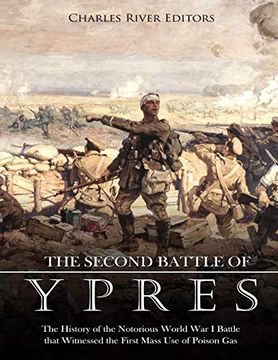The Second Battle of Ypres: The History of the Notorious World war i Battle That Witnessed the First Mass use of Poison gas (en Inglés)
Reseña del libro "The Second Battle of Ypres: The History of the Notorious World war i Battle That Witnessed the First Mass use of Poison gas (en Inglés)"
*Includes pictures *Includes accounts *Includes online resources and a bibliography for further reading *Includes a table of contents World War I, also known in its time as the “Great War” or the “War to End all Wars”, was an unprecedented holocaust in terms of its sheer scale. Fought by men who hailed from all corners of the globe, it saw millions of soldiers do battle in brutal assaults of attrition which dragged on for months with little to no respite. Tens of millions of artillery shells and untold hundreds of millions of rifle and machine gun bullets were fired in a conflict that demonstrated man’s capacity to kill each other on a heretofore unprecedented scale, and as always, such a war brought about technological innovation at a rate that made the boom of the Industrial Revolution seem stagnant. The arms race before the war and the attempt to break the deadlock of the Western and Eastern Fronts by any means possible changed the face of battle in ways that would have previously been deemed unthinkable. Before 1914, flying machines were objects of public curiosity; the first flights of any account on rotor aircraft had been made less than 5 years before and were considered to be the province of daredevils and lunatics. By 1918, all the great powers were fielding squadrons of fighting aircraft armed with machine guns and bombs, to say nothing of light reconnaissance planes. Tanks, a common feature on the battlefield by 1918, had not previously existed outside of the realm of science fiction stories written by authors like H.G. Wells. Machine guns had gone from being heavy, cumbersome pieces with elaborate water-cooling systems to single-man-portable, magazine-fed affairs like the Chauchat, the Lewis Gun and the M1918 BAR. To these grim innovations were added flamethrowers, hand grenades, zeppelins, observation balloons, poison gas, and other improvements or inventions that revolutionized the face of warfare. With the exception of a few hours on Christmas Day 1914, the shelling, sniping, raids, and bloodshed at Ypres in Belgium never ceased from the moment of first contact between the British Expeditionary Force (BEF) and the Imperial German army. The Ypres salient had formed the previous year during the “race to the sea,” when the opposing armies tried and failed to outflank each other in a series of maneuvers and counter-maneuvers. Still pleasant at the time of the First Battle of Ypres, the ground of the Ypres salient had deteriorated markedly by spring of 1915. At this point, the Germans had not yet leveled Ypres itself, though they had reduced the famous church and medieval Cloth Hall to rubble with long-range shelling. The Germans held the low ridges to the east, which surrounded the low ground held by the British in a bowl-like semicircle, with their “headquarters town” at Passchendaele. The Second Battle of Ypres resulted from the German decision to use poison gas against the Allied lines in an effort to produce a breakthrough. The French attempted the use of non-lethal tear gas first, in August 1914, after which the Germans did the same. Both attempts produced no results, and the Second Battle of Ypres would end inconclusively, but the gas attack opening this battle represented the first large-scale use of lethal chemicals in the war. The Second Battle of Ypres: The History of the Notorious World War I Battle that Witnessed the First Mass Use of Poison Gas analyzes one of the Great War’s most important conflicts, and how it was emblematic of the stalemate that came from new technology and trench warfare. Along with pictures of important people, places, and events, you will learn about the Second Battle of Ypres like never before.

